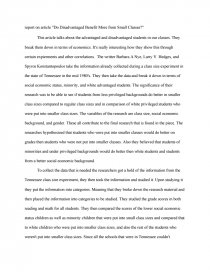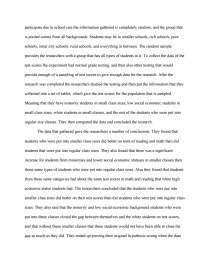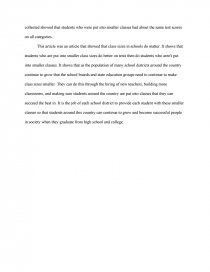Do Disadvantaged Benefit More from Small Classes?
Essay by review • November 1, 2010 • Article Review • 865 Words (4 Pages) • 1,499 Views
Essay Preview: Do Disadvantaged Benefit More from Small Classes?
report on article "Do Disadvantaged Benefit More from Small Classes?"
This article talks about the advantaged and disadvantaged students in our classes. They break them down in terms of economics. It's really interesting how they show this through certain expierments and other correlations. The writter Barbara A Nye, Larry V. Hedges, and Spyros Konstantopoulos take the information already collected during a class size experiment in the state of Tennessee in the mid 1980's. They then take the data and break it down in terms of social economic status, minority, and white advantaged students. The significance of their research was to be able to see if students from less privileged backgrounds do better in smaller class sizes compared to regular class sizes and in comparison of white privileged students who were put into smaller class sizes. The variables of the research are class size, social economic background, and gender. These all contribute to the final research that is found in the piece. The researches hypothesized that students who were put into smaller classes would do better on grades then students who were not put into smaller classes. Also they believed that students of minorities and under privileged backgrounds would do better then white students and students from a better social economic background.
To collect the data that is needed the researchers got a hold of the information from the Tennessee class size experiment, they then took the information and studied it. Upon studying it they put the information into categories. Meaning that they broke down the research material and then placed the information into categories to be studied. They studied the grade scores in both reading and math for all students. They then compared the scores of the lower social economic status children as well as minority children that were put into small class sizes and compared that to white children who were put into smaller class sizes, and also the rest of the students who weren't put into smaller class sizes. Since all the schools that were in Tennessee couldn't participate due to school size the information gathered is completely random, and the group that is pooled comes from all backgrounds. Students may be in smaller schools, rich schools, poor schools, inner city schools, rural schools, and everything in between. The random sample provides the researchers with a group that has all types of students in it. To collect the data of the test scores the experiment had normal grade testing, and then also other testing that would provide enough of a sampling of test scores to give enough data for the research. After the research was completed the researchers studied the testing and then put the information that they collected into a set of tables, which give the test scores for the population that is sampled. Meaning that they have minority students in small class sizes, low social economic students in small class sizes, white students in small classes, and the rest of the students who were put into regular size classes. They then compared the data
...
...


